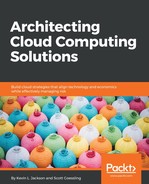The key performance indicators (KPIs) are used to measure goal attainment. Advance agreement on the relevance of the following cloud computing KPIs can assist in solution/business alignment:
- Time:
- Availability versus recovery SLA: Indicator of availability performance compared to current levels
- Timeliness: Degree of service responsiveness, which can be used to indicate rapidity of service choice determination
- Throughput: Transaction latency or the volume per unit of time throughput which measures workload efficiency
- Periodicity: Frequency of demand and supply activity or the amplitude of the demand and supply activity
- Temporal: The event frequency to real-time action and outcome result
- Cost:
- Workload-predictable cost: Indicator of CAPEX cost of on-premises ownership versus cloud
- Workload-variable cost: Indicator of OPEX cost for on-premises ownership versus cloud
- CAPEX versus OPEX cost: Indicator of on-premises physical asset TCO versus cloud TCO
- Server consolidation ratio: Ratio of servers in legacy infrastructure to the number used in the cloud infrastructure
- Workload versus utilization percentage: Indicator of cost-effective cloud workload utilization
- Workload type allocations:
- Workload size versus memory/processor distribution: Measures percentage of IT asset workloads using cloud
- Instance to asset ratio: Measures percentage and cost of IT consolidation
- Degree of complexity reduction (%): Measures the number of guest operating system instances versus the number of physical resource assets
- Tenancy to instance ratio: Measures tenants per resource, which measures CPU and memory utilization
- Ecosystem (supply chain) optionality: Tracks the use of commodity assets used to deliver company services after the function is migrated to a CSP
- Quality:
- Experiential—the quality of the perceived user experience of the service
- Basic quality of service metrics (availability, reliability, recoverability, responsiveness, throughput, manageability, security)
- User satisfaction
- Customer retention
- Revenue efficiencies
- Margin increase per unit revenue:
- Rate of increase of annuity income
- SLA response error rate
- Frequency of defective responses
- Intelligent automation—the level of automated response (agent)
- Margin:
- Revenue efficiencies—ability to generate margin increase per revenue.
- Rate of annuity improvement
- Market disruption rate—rate of revenue growth versus rate of new product customer acquisition
